How to Teach a Child to Tie His Shoes – Follow These Easy Steps
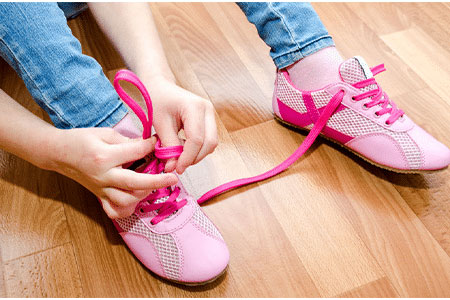
Undone shoelaces can create several problems such as compromising your child’s stability and making your child more prone to falling. There is a simple yet effective method I have been using to teach children how to tie their shoes.
At What Age Do Most Kids Learn How to Tie Their Shoes?
It depends on each child and whether they are ready and want to learn. I have noticed how most boys start tying their shoes when they are 7 years old or older, while most girls start tying their shoes when they are between the ages of 5 and 6. Girls are believed to have better motor skills than boys, so don’t be surprised if your daughter starts learning how to tie her shoes faster than your son.
If you allow your children to walk around with untied shoelaces you are making them more prone to falling and hurting themselves. There is a particular shoe lacing method that I learned from my co-worker who has been fitting children’s shoes for the last 20 years, which has proven to be the most effective one when it comes to teaching a child how to tie his or her shoes.
The Best Way to Teach a Child How to Tie His/Her Shoes
1️⃣ Cross the shoelaces to make an X and pull them tight:
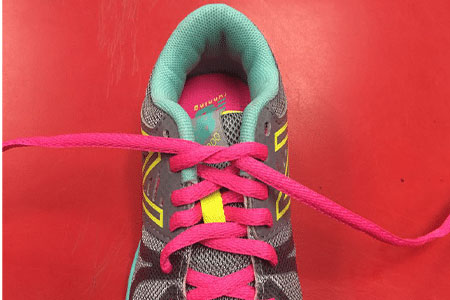
2️⃣ Repeat the same step and pull until you make a little circle:

3️⃣ Drop the shoelaces:
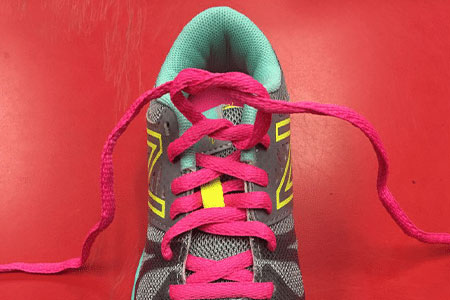
4️⃣ Take one of the shoelaces and put it through the circle, pull until there is a little loop at the top:
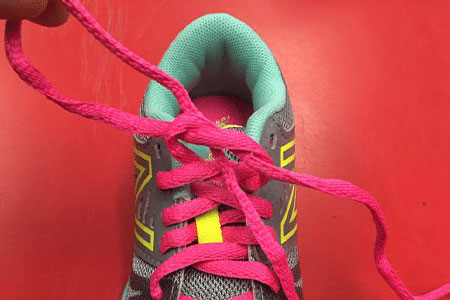
5️⃣ Repeat the same process with the other shoelace.
6️⃣ Grab the two loops that you created at the top and pull:

Done! That is the easiest way to teach a child how to tie his or her shoelaces.
Advantages of Shoelaces VS Velcro Shoes – Better Support and Stability!
My preference has always been shoelaces over velcro shoes. Shoelaces simply provide better support and stability for your child. They will also secure, protect, and support your child’s heels better.
Not all shoelaces are made the same way, and some are more durable than others. There are actually certain shoelaces that stay tied better. There is a pair of shoelaces that I recommend that are thicker and come with bumps, which prevent the shoelaces from becoming untied as often. Disclosure: Some links in this post may be affiliate links and we may receive a small commission (at no extra cost to you) when you click our links and make purchases.
The Best Shoelaces for Children
Below you can find a selection of the best shoelaces for children, including the ones that come with bumps and stay tied better.

- Order these shoelaces made by GREATLACES on Amazon
- Packing contains 2 Pair(4 Laces) tennis shoe laces
- Order the correct lace length by counting how may eyelets (shoe holes) your child’s shoes have

- Order these shoelaces made by GREATLACES on Amazon
- Packing contains 2 Pair(4 Laces) tennis shoe laces
- Order the correct lace length by counting how may eyelets (shoe holes) your child’s shoes have
How to Order the Correct Length for Your Child’s Shoelaces?
It’s important that you don’t provide your child with shoelaces that are too short or too long. Shoelaces that are too short make it harder for your child to learn how to tie the shoes, while shoelaces that are too long might make your child step on them and fall. To figure out the perfect shoelace length, count the eyelets of the shoe —aka holes where the laces go through— and then look at the chart below:
| Pair of Eyelets | Inches | Centimeters |
| 4 | 27’’ | 69 |
| 5 | 36’’ | 91 |
| 6 | 40’’ | 102 |
| 7 | 45’’ | 114 |
| 8 | 54’’ | 137 |
| 9 | 63’’ | 160 |
| 10 | 72’’ | 183 |
How to Tie Shoes for Kids Who Wear Orthotics – Let’s Find Out!
The best way to tie shoelaces for children who wear orthotics inside their shoes is through the “reverse the laces technique”. I use this shoe-lacing technique for every child that comes to the store wearing orthotics.
Parents need to understand that for their children to get the full benefits that the orthotics have to offer, the shoes must be tied properly. There is another article I wrote where I describe the most effective way to tie shoes with orthotics.
You can also use this shoelace tying technique if you have a child at home with narrow feet. It will help fill out any remaining gap around your kids’ heels and prevent your child’s heels from moving up and down the shoes. I actually tie my running sneakers this way and I feel so much more secure and stable when I am running.
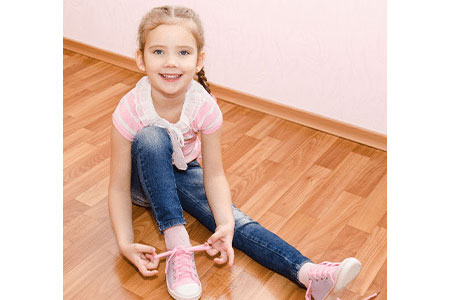
Please emphasize to your kids to please undo the shoelaces or velcro closure when they are putting their shoes on and when they are taking them off. The reason I mention this is that every time your children yank the shoes off, they are stretching the back part of the shoes (heel counter), which leads to the shoes providing less support, and you might have to end up replacing the shoes faster than you expected. It is all about making it a good habit!
I understand that some parents and children try to avoid shoelaces at all costs, especially with so many options of velcro sneakers available. Children are increasingly avoiding hard things and that in itself is not a good idea. Learning how to tie their shoelaces might sound like a simple task, but it actually requires effort and practice. Making your children familiar with the idea of putting effort into things is a good thing because much of what children need to do at school takes effort and practice.
If mom and dad are desperate to switch their children from velcro to lace up shoes, my advice will be to only do it if you are going to put the time and effort to teach your child how to properly tie the shoes.
The Best Shoe Lacing Techniques
I wanted to leave you with some of the most popular shoe-lacing techniques based on your child’s foot shape which can be narrow heel with wide toe box, wide feet, and narrow feet.
Have you tried another shoe lacing technique that has been effective in teaching your child how to tie his/her shoes? Please share your findings in the comments section below so other parents can benefit from your experiences.

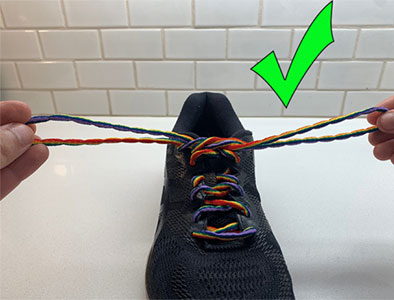
I have a 9 yr old with autism who struggles with tactile tasks such as shoe tying, so sometimes its not about just age….. we went to velcro just due to the meltdowns over shoes in general……
He also has a wide foot 7.5 I guess adult size now YES he’s a big boy…. so I appreciate your advice on that.
Thanks for the suggestions.
Hello Ann,
Wow he does have large feet 🙂
You are right that sometimes it’s not about age, since I have met several boys older than your son’s age who still didn’t know how to tie his shoes. The issue is that the older they get and the larger their shoe size is ,the selection of velcro sneakers drops considerably.
I can provide with a selection of velcro shoes in large sizes (it will be small), but what I recommend is choosing a shoe with shoelaces and then replacing the laces with ‘Toggle Shoe Laces”, which will allow you to turn any pair of lace-up tennis shoes into slip on sneakers.
There is an article I wrote where you can learn more about these Toggle Shoe Laces:
Toggle Shoe Laces – Never Tie Your Shoes Again
I hope this helps!
Holy cow! This website was so helpful for me. I have 4 children and I have struggled each and every-time trying to teach them how to tie their shoes. My 8 year still struggles to tie his shoes and even more keeping them tied.
I also found information in here that I had no idea about. I will definitely be coming back to read some more and to get those shoelaces.
Kristena,
I am sure it is hard to keep up with four children. I see children all day, and I get to laugh, talk, and play with them. Parents always ask me how tired I am at the end of the day and I always say I am not tired at all, I get to have all the fun with them and then they go back with their parents. They are the real heroes. The fact that your 8 year old learned how to tie his shoes it must one less thing you have to worry about. Try the laces with the bumps, they tend not to become untie as often!
This is a great post! And extremely helpful! There are so many benefits to wearing a pair of shoes that fits well and you want to start your child off on the right foot! We are currently trying to teach our son on how to tie his shoes properly and he is doing great. It is quite a process and you must have patience. We are making his practice even though lately he has been wearing boots because we live in area that gets snow. This way he will be ready to go in the Spring! I found out first hand what can happen to you if you don’t wear the proper footwear and one surgery later I am still having problems! Great work!
I am sure he will learn soon. Keep in mind that it usually takes boy”s longer than girl’s to learn how to tie their shoe laces so hang in there!
Hi Juan! Great post. I had no idea there would be so many problems associated with improperly tied shoes. It makes me think more about my running shoes. My 3-and-a-half-year-old twin daughters are currently wearing easy velcro shoes but have worn lace-up shoes in the past. I love your tips for how to treat different shaped feet – my daughters have completely different feet so they usually cannot wear the same shoe. We were just “fitted” for some Mary Jane type shoes last week. How can I tell if it was a proper fitting done by someone who cares or a useless practice rushed by a sales-oriented person? When it comes to lace-up shoes, what should I expect from a good salesperson?
Carmen,
It is hard for me to assess if her shoes are fitting or not without looking at her feet. The most common problem I see with mary jane shoes is that sometimes they are not fitted properly around the width. See if you can slide your finger around the instep of your daughter foot. If your finger does not fit in that area then it means the shoe is not wide enough, if you can comfortable fit one of your fingers around this area then it is fine. I hope this helps.
I have wondered why some adults cannot tie their shoe laces. Is it from not being taught when they were young or from circumstance, like their family were too poor to buy them shoes, so there was no opportunity to learn how to tie shoe laces. I like the information about the number of eyelets in relation to lace length. I never knew about this and valuable info when I shop for next pair of shoe laces. I personally don’t like velcro shoes. Not only do they not look nice, it makes people lazy. I guess its for convenience, like a lot of things in life. Good post!
Tony,
I am glad you found the post informative. I believe adults cannot tie their shoe laces properly because of lack of information and not knowing the benefits and drawbacks that occur when not tying the shoe laces.
I never thought I would read an article about how to tie shoes, but it had some interesting information about the subtleties of tying a shoe vs using velcro.
Also for the explanation of tying the shoe, perhaps you could have a video along side with it for people who are more visual learners. 🙂 I just can’t visual what the directions are just based on the text.
Tim,
Thank you for your input. I might insert a video in this post to make my explanation clearer.
hahaha I liked your first phrase! “It is incredible the amount of children and adults I see every day that do not know how to tie their shoe laces properly.” It made me think that am I also tying my shoes wrong and after reading your text it seems that, yes I’m tying my shoes wrong.
I also liked the thought take make this into a game with children! Every child will learn it sooner or later with proper practice 🙂
-Roope
Roope,
It is important to keep the shoe laces tight. I am glad you enjoyed the post.
I remember with pleasure an evening when my eldest son was 5 years old, the school where he was terrorized with learning binding laces, it was practically a sample that has to perform ;in an evening when he went to sleep I hear him saying:
“God, please help me learn to read and write and tie my laces.”
It was good to read an article so then, but as it’s never too late, it’s fine now,too.
Dorina,
That is too funny. You should have offered him help right away! Thank you for sharing that.
Hi. Great article. I agree with you. There are many who are unaware of how to tie their shoes and to tie them properly. I can’t remember how many times I tripped and fell when I was young because my shoelaces were loose. I’ve also tripped and fallen because my shoe laces were not tied properly (the ends of the shoe laces were hanging over my shoes to far). This is very good practical advice. This is also important for safety. Good use of the ‘eyelets’ chart. I never thought much about the eyelets, however, I can now see why they are important. Thanks again for the good advice.
Sir,
I am glad you found the article helpful. Some parents are unaware of the importance of the shoe laces being the right size, and that is what inspired me to write this article.
Interesting! This article actually just brought on quite the conversation at my house. It led to a discussion about how tie your laces properly. Definitely a skill we take for granted.
It is interesting that I found this article. I did a Child Development course that required us to write a lesson plan for teaching a child to properly tie their shoelaces. We were beyond amazed to see how many steps are actually involved when the child knows absolutely nothing. Your article just emphasized why it is so darn important.
I have a 4 year old who is currently wearing anything that doesn’t have laces.lol Everything from cheap knock off crocs to velcro sneakers. At what age do you recommend that a child should learn to tie shoe laces? I fear that if I introduce shoe laces she will end up tripping over them.
And one more Question? Why are shoe laces so long? I have two pairs of sneakers that even with a double knot, the laces are just way too long.
This was a very informative post. Thank you!
Melody,
What is the name and age of your child? Girls tend to start tying their shoes at age six while it usually takes longer for boys,they might start at age seven or older. If you believe your child has stability issues or needs the most support from the shoes, I will advise you to start getting him/her laces and dealing with the tying yourself.
I have seen shoes that come with laces that are too long and also in certain instances too short. Are you sure you are using all the eyelets (holes) in the shoe? I provide a chart where you can find the right size of laces for your shoes. I am glad you found the article informative.
Great post, especially since I never really thought about the importance of lacing up shoes properly until recently.
My daughter is turning 4 this month and she has her first pair of lace up shoes. Until now she has been wearing velcro shoes.
I am trying to teach her how to tie her own laces but it seems we will be needing some more time for that 🙂
So anyway, back to the importance of tying the laces properly. Until my daughter started wearing shoes with laces it never crossed my mind about how tight or loose to tie the laces! Now of course that my most precious cargo has laces it made me realize it is important. I tie them quite tight and I do a double lace on it so it can’t come undone easily!
Lynne,
It is a great advantage that she will be wearing lace up shoes, since laces always provide more support and stability to the child.However,trying to teach her at age four might be a little too ambitious. I will say that girls tend to start tying at age six or seven, usually at a younger age than boys since girls have better motor skills.However, if she sets her mind into it I am sure she will get it with no problem. Good luck and keep me posted I will be curious to know if she learns how to tie.
Dear Juan,
I can honestly say I struggled with tying my shoes when I was 8 years old. I wanted it to be perfect and neat but didn’t know how. So, in the mean time I devised a method that worked for me and stuck with it.
I made 2 bunny ears with my 2 laces, brought them near each other, and let one bunny ear go under the other, and then finally pull the 2 bunny ears together. It has still worked well for me to this very day.
I have seen videos of complicated methods that people have done to tie their shoes, do you know of any? How about on BuzzFeed?
Wishing you all the best with your online success above and beyond the horizon,
~Angel
Angel,
I will be uploading a video explaining how to tie your shoes shortly.The bunny years might be the most popular method. Thank you for sharing 🙂